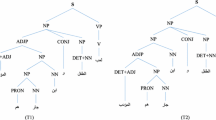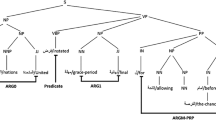Abstract
The aim of this paper is to describe a technique for identifying the sourcesof several types of syntactic ambiguity in Arabic Sentences with a singleparse only. Normally, any sentence with two or more structuralrepresentations is said to be syntactically ambiguous. However, Arabicsentences with only one structural representation may be ambiguous. Ourtechnique for identifying Syntactic Ambiguity in Single-Parse ArabicSentences (SASPAS) analyzes each sentence and verifies the conditionsthat govern the existence of certain types of syntactic ambiguities in Arabicsentences. SASPAS is integrated with the syntactic parser, which is basedon Definite Clause Grammar (DCG) formalism. The system accepts Arabicsentences in their original script.
Similar content being viewed by others
References
Al-Douri, Z. “Using the Computer for Processing Simple Arabic Sentences”. MS Dissertation, University of Technology, Iraq, 1992.
Ali, N. Arabic Language and the Computer. Cairo: Ta'reeb, 1988.
Allen, J. Natural Language Understanding. California: Benjamin/Cummings, 1995.
Bear J. and J.R. Hobbs. “Localizing Expressions of Ambiguity”. SRI International, Technical Note, 428 (1987), 1–19.
Brysbaert, M. and D.C. Mitchell. “Modifier Attachment in Sentence Parsing: Evidence from Dutch”. Experimental Psychology, 49 (1996), 664–695.
Chiang, T., Y. Lin and K. Su. “Robust Learning, Smoothing, and Parameter Tying on Syntactic Ambiguity Ressolution”. Computational Linguistics, 21 (1995), 321–349.
Chiang, T., Y. Lin and K. Su. “Syntactic Ambiguity Resolution Using a Discrimination and Robustness Oriented Adaptive Learning Algorithm”. Proceedings for the 15th International Conference on Computational Linguistics. Nantes, 1992.
Clifton, C., S. Kennison and J. Albrecht. “Reading theWords Her, His, Him: Implications for Parsing Principles Based on Frequency and on Structure”. Memory and Language, 36 (1997), 276–292.
Daimi, K.A. and M. Abdel-Amir. “The Syntactic Analysis of Arabic by Machine”. Computers and the Humanities, 28 (1994), 29–37.
Daimi, K. “Techniques for Handling ill-formed Arabic Sentences”. Proceedings of SNLP'95 Symposium on Language Processing. Bangkok, 1995.
Gazdar, G. and C. Mellish. Natural Language Processing in Prolog. Workington: Addison Wesley, 1989.
Hamoody, Z.S. “Designing a System for Resolving Ungrammatical Errors in Arabic”. MS Dissertation, University of Technology, Iraq, 1991.
Hassan, S.D. Translation: Issues, Problems and Solutions - Human and Machine Translation. Arab Bureau of Education for Gulf States, 1985.
Hindle, D. and M. Rooth. “Structural Ambiguity in Lexical Relations”. Computational Linguistics, 19 (1993), 103–120.
Hurum, S. “Handling Scope Ambiguities in English”. Proceedings of the 2nd Conference on Applied Natural Language Processing. Austin, 1988.
Juliano, C. and M. Tanenhaus. “Contingent Frequency Effects in Syntactic Ambiguity Resolution”. Proceedings of the 15th Annual Conference of the Cognitive Science Society. Hillsdale, 1993.
MacDonald, M. “Probabilistic Constraints and Syntactic Ambiguity Resolution”. Language and Cognitive Processes, 9 (1994), 692–715.
MacDonald, M., N. Pearlmutter and M. Seidenberg. “Syntactic Ambiguity Resolution as Lexical Ambiguity Resolution”. In Perspectives on Sentence Processing. Ed. C. Clifton, L. Frazier and K. Rayner. Hillsdale, 1994.
Ni, W. and S. Crain. “How to Resolve Structural Ambiguities”. Proceedings of the North East Linguistic Society, 20. Amherst, 1990.
Pereira, C.N. and H.D. Warren. “Definite Clause Grammars for Language Analysis: A Survey of the Formalism and Comparison with Augmented Transition Networks”. Artificial Intelligence, 13 (1980), 231–278.
Spivey-Knowlton, M. and J.C. Sedivy. “Resolving Attachment Ambiguities with Multiple Constraints”. Cognition, 55 (1995), 227–267.
Trueswell, J., M. Tanenhaus and S. Garnsey. “Semantics Influences on Parsing: Use of Thematic Role Information in Syntactic Disambiguation”. Memory and Language, 33 (1994), 285–318.
Author information
Authors and Affiliations
Rights and permissions
About this article
Cite this article
Daimi, K. Identifying Syntactic Ambiguities in Single-Parse Arabic Sentence. Computers and the Humanities 35, 333–349 (2001). https://doi.org/10.1023/A:1017941320947
Issue Date:
DOI: https://doi.org/10.1023/A:1017941320947




